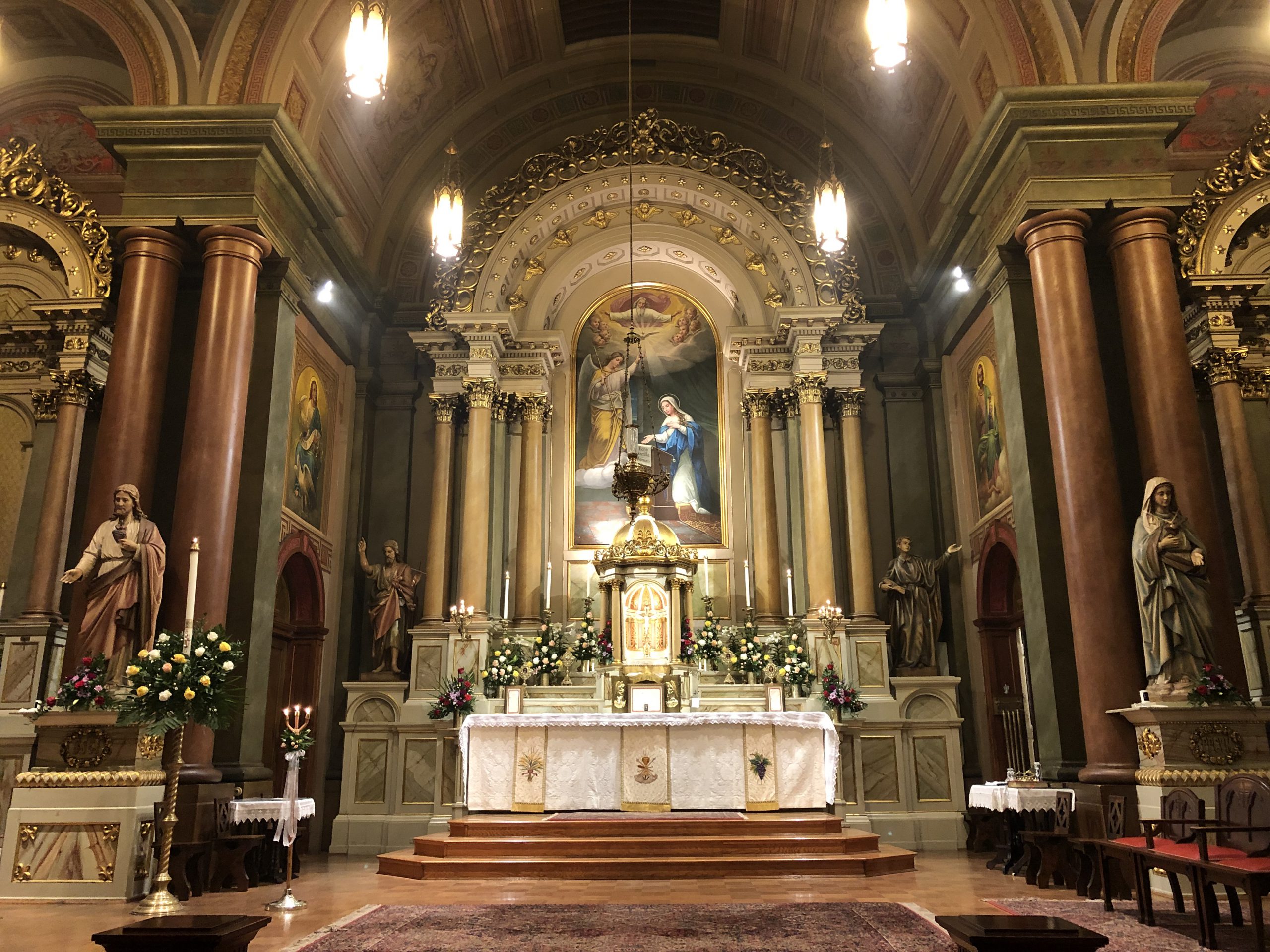Interim Pastor and Builder of numerous churches- 1843-1844
Joseph Ferneding, born in Ihorst/Holdorf, Germany in 1802. Upon completing his theological preparatory training in April 1832 he departed for America, via the entry port of Baltimore. From there he departed for Cincinnati and enrolled at the Seminary for Priests at Bardstown, KY. In 1833 he was ordained there. He saw his task as being a source for religious guidance and spiritual support to the far-flung Catholic farmers of the land.
In 1849 he founded the St. Paul’s Church in Cincinnati and remained as its Pastor until 1866. At the same time he was Head Administrator of a Catholic Orphanage in Cincinnati. When he died in February 1872 a major figure of the emigration of South Oldenburg left with him.
When Joseph Ferneding first arrived in early 1832, the original Cathedral of St. Peter in Chains had been built six years earlier on Sycamore St., within the city limits, after anti-Catholic bigotry had quieted. By 1833 the Cathedral had been enlarged, a school and the Athenaeum, a college for teachers in the diocese, added along Sycamore.
Despite Fr. Ferneding’s recent arrival, Bishop Purcell appointed him Vicar General of the Diocese, replacing Fr. Henni, to serve as surrogate for the bishop, and perhaps more importantly as his counselor and friend. He was also appointed Director of St. Aloysius Orphanage, which Fr. Henni had founded and directed.
In April 1842, upon his return from evangelizing the frontier, he was assigned as assistant pastor to St. Mary’s. The church building was nearing completion under Fr. Henni’s direction. When the pastor, Fr. Clemens Hammer left on a trip to Europe in 1843, Fr. Ferneding was named interim pastor. During his tenure he added a school building.
In 1844, after the return of Fr. Hammer and at the bishop’s request, Fr. Ferneding started the planning, land purchase and fund raising for another church, St. John the Baptist, Green St. in the Mohawk area of Over-the-Rhine. St. John Church was completed in November of 1845. Another, larger church, the present St. Peter in Chains Cathedral, was built on Plum St. and also dedicated that November, with the building finally completed in 1851.
As these city parishes grew to over-flowing the need for another new church, east of St. Mary’s, became pressing. The bishop asked Fr. Ferneding to select a plan and start building another church, to be named St. Paul the Apostle, where land could be purchased in the Over-the-Rhine. Early in 1848 Ferneding recruited as his advisory and building committee: B. H. Dodt, B. H. Fedders, E. H. Greiwe, H. H. Himmelgarn, H. Kronlage and H. Menkhaus, with J.B. Moorman as legal advisor.
Negotiations were begun with N. G. Pendleton and Mr. Hunt for purchase of land tracts totaling six acres (four city blocks) between Broadway and Pendleton St., and Woodward and Lebanon Turnpike. The land, about five blocks east of St. Mary’s, was bought in February, 1848 for $95,000 (about $1.4 million in 1999 dollars), with the first payment of $25,000 ($375,000 in today’s dollars) not made until May.
Work on St. Paul Church was stopped during those terrible months of June, July and the first half of August, 1849. Construction resumed through the rest of the year, with temporary stoves placed in the church to allow the plaster and paint to dry. On January 20, 1850 the work was completed. The parishioners funded this work without seeking help from the other Catholic parishes. Fr. Ferneding’s bold plan to develop a large tract and sell lots for homes near the church worked. The sale of lots paid for the cost of the land and provided a gain of $11,000 ($165,000 in 1999 dollars) that was applied to the building costs.
Fr. Joseph continued his pastorship until 1866. He asked the archbishop then to relieve him of his duties there and to reduce his responsibilities at age 64 to resident director at St. Aloysius Orphanage. The Civil War had ended. His health was fragile after all of his years of service. His nephew Fr. Herman succeeded him at St. Paul, and he frequently returned to visit him, Joseph’s sister “Kate” and his old parishioners.
The move to St. Aloysius Orphanage brought him in daily contact with the children he loved. He was their spiritual father, mentor and friend on a daily basis in these last years of his life. On January 30, 1872 he collapsed after giving First Communion instruction to the children. He had suffered a severe stroke.
Father Ferneding died at the orphanage, after two days in and out of consciousness, receiving the Last Rites and blessed by the archbishop. He was nearly 70 years of age. He had survived five ocean crossings plus many miles on horseback through the Indiana and Ohio wilderness. Archbishop John Purcell spoke of his friend at his Requiem Mass at St. Paul Church; he quoted Paul’s Second Letter to Timothy (IV, 6-9) as a tribute to Joseph: “I have fought the good fight, I have stayed the course, I have kept the faith. For the rest, there is laid up for me a crown of justice, which the Lord, the Just Judge will give to me on that day, yet not to me only, but also to those who love His Coming.”
